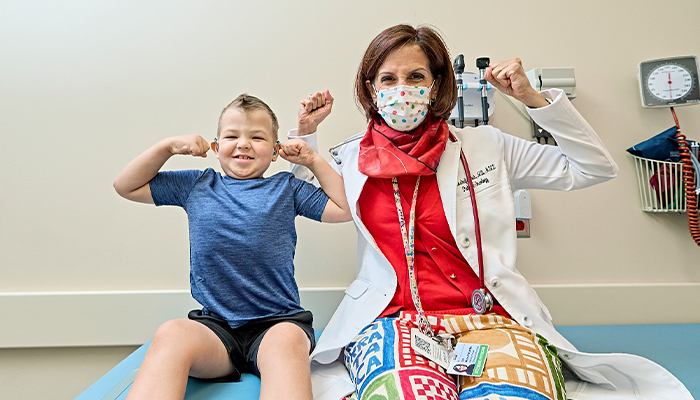HOW CAN WE HELP YOU? Call 1-800-TRY-CHOP
In This Section
CHOP Researcher Leads Neuroblastoma Guidelines Development

CHOP’s Rochelle Bagatell, MD, led the development of the first-ever NCCN guidelines for neuroblastoma. The guidelines will help clinicians like Sogol Mostoufi-Moab, MD, (pictured) direct treatment for patients who have a highly heterogenous disease.
By Lauren Ingeno
The National Comprehensive Cancer Network (NCCN) — an alliance of leading cancer centers — has published its first-ever set of recommendations for treating neuroblastoma. Children's Hospital of Philadelphia's Rochelle Bagatell, MD, professor of Pediatrics and Solid Tumor Section Chief, chaired the multidisciplinary panel that developed the NCCN guidelines, which will help to direct treatment of a highly heterogeneous disease.
Neuroblastoma, which most often presents in children under 5, is a tumor that develops in early forms of nerve cells, commonly in the abdomen. While rare, it is the third most common childhood cancer with more than 700 cases diagnosed in the United States every year. Survival rates are higher than 90% for patients with low- and intermediate-risk neuroblastoma and around 50% for those with high-risk disease.
Due to the diversity of the disease's severity, symptoms, and progression, information about risk stratification is particularly important for medical teams' decision-making processes.
"There are some children who need minimal therapies, even just observation in some extreme cases, all the way to the most complex multimodality treatments in other cases," Dr. Bagatell said. "In pediatrics, you don't want to undertreat or overtreat — you really need to right-size it. That's why these nuanced, detailed guidelines are so helpful for clinicians and for families."
A multidisciplinary group of clinicians from medical institutions across the country, including oncologists, pathologists, radiologists, radiation oncologists, and surgeons, created the guidelines. They contain evidence-based recommendations and visual aids about how to choose the most beneficial treatments and minimize side effects, as well as how to incorporate the multidisciplinary care, such as surgery, radiation, and chemotherapy regimens.
Beyond providing information to clinicians, the new NCCN recommendations also could play a role in securing insurance coverage for certain treatments, Dr. Bagatell said.
"Having these guidelines available could make an insurance company more likely to cover a particular procedure because they have evidence that it is standard of care," she said.
There are now 87 different NCCN Clinical Practice Guidelines in Oncology. The NCCN Guidelines for Neuroblastoma are the sixth to focus specifically on treating pediatric cancer. Frank Balis, MD, director of Clinical Cancer Research at CHOP, chaired the NCCN guidelines panel for Wilms' tumor in 2021.
Dr. Bagatell will be presenting a virtual session on the latest updates for neuroblastoma in the new NCCN Guidelines as part of the NCCN 2024 Annual Conference April 5 to 7. Visit NCCN.org/conference to learn more and register.
